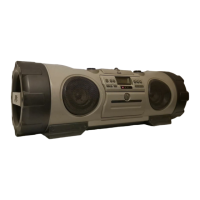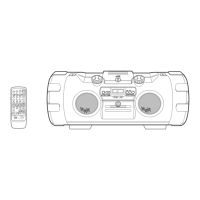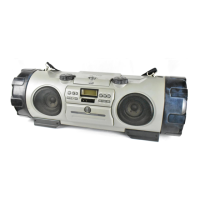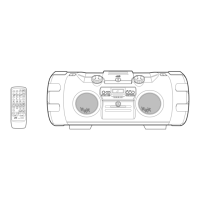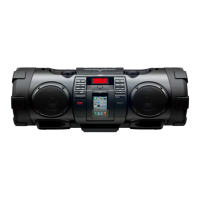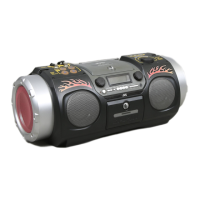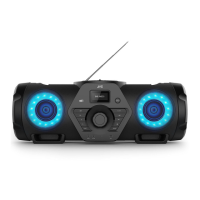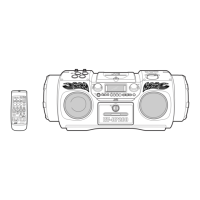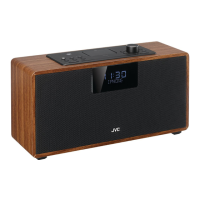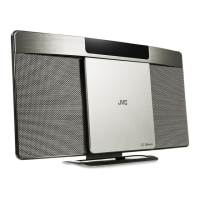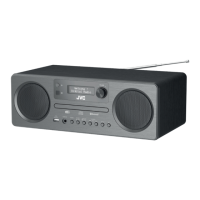2
ENGLISH ESPAÑOL PORTUGUÊS
Thank you for purchasing this JVC product.
Please read these instructions carefully before
starting operation to be sure to obtain optimum
performance and a longer service life from the
unit.
Le agradecemos la adquisición de este producto
de JVC. Por favor lea detenidamente las
instrucciones antes de comenzar la operación
para obtener de esta unidad un rendimiento
óptimo y una vida de servicio más larga.
INDICE ÍNDICE
Características .................................... 3
Precauciones de seguridad ............... 4
Precauciones de manipulación ......... 5
Colocación/extracción de la correa
para el hombro .................................... 7
Conexiones.......................................... 8
Alimentación........................................ 8
Nombres de las partes y sus
funciones ........................................... 12
Unidad de control remoto ................ 14
Conexión/desconexión de la
alimentación ...................................... 16
Volumen, modo de sonido y otros
controles ............................................ 17
Manipulación de CD.......................... 19
Reproducción de CD......................... 20
Manipulación de cassettes de cinta 24
Reproducción de cassettes ............. 25
Empleo de otra unidad de audio...... 26
Radiorrecepción................................ 26
Grabación .......................................... 30
Mezcla de micrófonos (RV-B90U/
UB/US/UT/UX exclusivamente) ........ 33
Ajuste del reloj .................................. 34
Operaciones por temporizador........ 35
Mantenimiento................................... 40
Detección de problemas................... 41
Especificaciones ............................... 42
Features ............................................... 3
Safety precautions .............................. 4
Handling precautions ......................... 5
Shoulder strap attachment/
detachment .......................................... 7
Connections ........................................ 8
Power supply....................................... 8
Names of parts and their functions. 12
Remote control unit .......................... 14
Switching the power on/off .............. 16
Volume, sound mode and other
controls .............................................. 17
Handling CDs..................................... 19
Playing CDs ....................................... 20
Handling cassette tapes. .................. 24
Cassette playback............................. 25
Using with another audio unit.......... 26
Radio reception ................................. 26
Recording .......................................... 30
Microphone mixing (RV-B90U/UB/
US/UT/UX only).................................. 33
Clock adjustment .............................. 34
Timer operations ...............................35
Maintenance ...................................... 40
Troubleshooting ................................ 41
Specifications.................................... 42
A JVC do Brasil agradece pela compra do
RV-B90. Aconselhamos que leia atentamente
este manual de instruções antes de utilizar o
aparelho para ter a certeza de obter o seu
melhor desempenho possível e prolongar a sua
vida útil.
CONTENTS
CUIDADO:
PARA REDUZIR O RISCO DE INCÊNDIO
OU CHOQUE ELÉTRICO, NÃO
EXPONHA ESTE APARELHO À CHUVA
OU UMIDADE.
WARNING:
TO REDUCE THE RISK OF FIRE OR
ELECTRIC SHOCK, DO NOT EXPOSE
THIS APPLIANCE TO RAIN OR
MOISTURE.
CAUTION
RISK OF ELECTRIC SHOCK
DO NOT OPEN
CAUTION: TO REDUCE THE RISK OF ELECTRIC SHOCK.
DO NOT REMOVE COVER (OR BACK).
NO USER-SERVICEABLE PARTS INSIDE.
REFER SERVICING TO QUALIFIED SERVICE PERSONNEL.
The lightning flash with arrowhead symbol, within an
equilateral triangle, is intended to alert the user to the
presence of uninsulated "dangerous voltage" within the
product's enclosure that may be of sufficient magnitude
to constitute a risk of electric shock to persons.
The exclamation point within an equilateral triangle is
intended to alert the user to the presence of important
operating and maintenance (servicing) instructions in
the literature accompanying the appliance.
ADVERTENCIA:
PARA REDUCIR EL RIESGO DE
INCENDIO O DE CHOQUES
ELECTRICOS, NO EXPONGA ESTE
APARATO A LA LLUVIA O A LA
HUMEDAD.
Características .................................... 3
Precauções .......................................... 4
Cuidados com relação
ao manuseio ........................................ 5
Colocação/retirada da alça
de ombro.............................................. 7
Conexões ............................................. 8
Alimentação......................................... 8
Controles e funções.......................... 12
Controle remoto ................................ 14
Como ligar/desligar........................... 16
Volume, Sound Mode e
outros controles................................ 17
Manuseio de CDs .............................. 19
Reprodução de CDs.......................... 20
Manuseio de fitas cassete................ 25
Reprodução de fitas.......................... 26
Uso com outros aparelhos
conectados ........................................ 26
Recepção de FM, AM e SW .............. 26
Gravação............................................ 30
Mixagem de microfone ..................... 33
Ajuste do relógio............................... 34
Operações com timer ....................... 35
Manutenção ....................................... 40
Identificação e correção
de problemas..................................... 41
Especificações .................................. 42
CUIDADO
RISCO DE CHOQUE ELÉTRICO.
NÃO ABRA
CUIDADO: PARA REDUZIR O RISCO DE CHOQUE ELÉTRICO,
NÃO RETIRE A TAMPA (OU A PARTE TRASEIRA). NÃO HÁ
PEÇAS QUE POSSAM SER CONSERTADAS PELO USUÁRIO
NO INTERIOR DO GABINETE. ENCAMINHE OS CONSERTOS
A UM POSTO AUTORIZADO DE ASSISTÊNCIA TÉCNICA.
O símbolo do raio com ponta em forma de flecha dentro de um
triângulo equilátero destina-se a alertar o usuário sobre a
presença de "tensões perigosas" e sem isolamento dentro do
gabinete do produto, que podem ser de magnitude suficiente
para representar um risco de choque elétrico para as pessoas.
O ponto de exclamação dentro de um triângulo equilátero
destina-se a alertar o usuário sobre a existência de instruções
de operação e manutenção (assistência técnica) importantes
na literatura que acompanha o produto.
